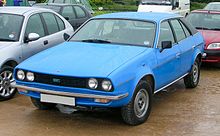Princess (make of car)
Princess (also Leyland Princess ) was initially the model name of several high-quality sedans from the British car manufacturer British Motor Corporation (BMC). Under its successor British Leyland Motor Corporation (BLMC), the Princess existed from 1975 to 1982 as an independent brand within the group.
Background: Princess as a model name
The name Princess first appeared in 1947 as an addition to Austin A135 vehicles . An attempt to establish the name Princess independently of Austin as an independent brand was made from 1957 with the "Princess IV", the "Princess 4-liter sedan" and the "Princess 3-liter". These were large, traditional representative limousines.
In 1959, BMC turned the company Vanden Plas, which had previously only been a body manufacturer, into an independent car manufacturer and its own group brand. Vanden Plas then marketed the A135 representative limousine, which had been commissioned by Vanden Plas for years, as a separate model under the name Vanden Plas Princess 4 liter limousine . There was also the smaller model Vanden Plas Princess 3 Liter , which was further developed in 1964 to the Vanden Plas Princess 4 Liter R. Both were high-priced vehicles that were technically related to different models of the BMC Group, but had high-quality equipment, partly an individual design and an independent engine. The Princess 4 Liter R was equipped with a six-cylinder engine that Rolls-Royce had developed for the Rangoon prototype . After the Vanden Plas parent company BMC took over the luxury class manufacturer Jaguar in autumn 1969 , the production of independent Vanden Plas models was discontinued.
The Vanden Plas Princess 1100 was also sold ; However, this was not a stand-alone model, but only a variant of the small car BMC ADO16 modified by way of badge engineering . When production was discontinued in 1974, the name Princess was temporarily dropped. British Leyland also offered a Vanden Plas version of the Austin Allegro , the successor to the ADO16, but it was not called Princess.
Princess as an independent brand
Until the 1970s, BMC and its successor BLMC were represented in the middle class with the front-wheel drive models of the BMC ADO17 series designed by Alec Issigonis. These technically innovative, stylistically unusual and mocked as Landcrab (land crab) cars were, following the concept of badge engineering , sold under various corporate brands as Austin 1800 or 2200 , Morris 1800 or 2200 and as Wolseley 18/85 or Six .
In March 1975, BLMC presented the ADO71 hatchback sedan designed by Harris Mann, a successor to the Landcrab . This series, also known as the 18-22 Series , initially appeared again in different versions as Austin, Morris and Wolseley. However, after just six months, BLMC gave up the concept of badge engineering completely. The 18-22, which was introduced three times at great expense, was only sold as a single model from October 1975. The vehicle was no longer assigned to any of the traditional BMC or BLMC brands, but became a brand-independent solitaire. For this model, the name Princess, which had been discontinued ten years earlier, was revived, which has now become an independent sales line, and according to some sources also an independent brand. The car remained in the Leyland range until 1981 as the Princess or Princess 2. Its technically and stylistically similar successor was sold under the name Austin Ambassador from 1981 .
Web links
- Extensive documentation (English)
- Unofficial Austin-Rover Web Resource
- Club page ( Memento from August 20, 2008 in the Internet Archive )


